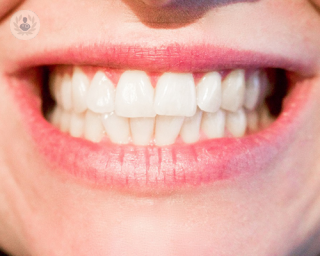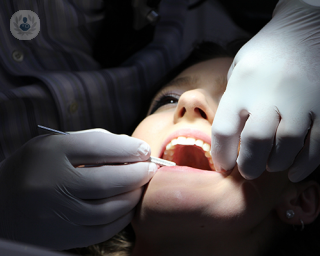What are veneers?
Veneers and crowns are aesthetic solutions for covering damaged teeth. There are two types of veneer: composite veneers or porcelain veneers. They are made of metal, ceramic or porcelain fused on metal. Generally, their placement does not require anaesthesia, as it is relatively fast as a procedure, although porcelain veneers are placed under local anaesthesia to avoid sensitivity and any pain.

Why are veneers used?
Veneers can be placed with several objectives:
- Covering tooth fractures
- Covering interdental spaces
- Correcting tooth shapes
- Enlarging the teeth
- Teeth whitening
Thus, they are indicated especially for patients with cavities or any breaks or abnormalities that cannot be repaired.
What does a veneer procedure consist of?
Veneers are a thin sheet made to measure that is only placed on the external face of the tooth, attached permanently by a type of cement imperceptible to the eye.
On the first visit, the patient explains their expectations and their underlying problem and the dentist examines the teeth to evaluate the most appropriate treatment options.
At the second visit, if the veneers are composite, they may be placed at the time as the procedure is simpler. However, if porcelain veneers are used, the teeth are cut a little and measurements are taken as dental impressions, and, in some cases, radiographs. This data is sent to the laboratory to manufacture the veneers, customised to the individual, so that the veneers adjust to each tooth.
Finally, on the third visit, the porcelain veneers are placed by applying a special cement so that they remain fixed.
Preparing for a veneers procedure
It should be noted that the veneers cannot be placed if there are oral health problems, since the veneers do not solve them, but mask them. So, before the placement, these problems must be addressed.
What's involved in aftercare?
Once the veneers are placed, it is important to follow the following tips to maintain good care:
- Brush the teeth well
- Floss
- Do not smoke
- Take care with drinks such as coffee, tea, juices, wine or similar drinks which can stain teeth
- Do not consume too many sauces, especially ketchup and mustard
- Undergo professional cleanings periodically
- Do not bite objects to cut or hold them
- Do not squeeze or grind your teeth
- Be careful with some sports in which you can receive a blow to the mouth
Veneers
What are veneers?
Veneers and crowns are aesthetic solutions for covering damaged teeth. There are two types of veneer: composite veneers or porcelain veneers. They are made of metal, ceramic or porcelain fused on metal. Generally, their placement does not require anaesthesia, as it is relatively fast as a procedure, although porcelain veneers are placed under local anaesthesia to avoid sensitivity and any pain.

Why are veneers used?
Veneers can be placed with several objectives:
- Covering tooth fractures
- Covering interdental spaces
- Correcting tooth shapes
- Enlarging the teeth
- Teeth whitening
Thus, they are indicated especially for patients with cavities or any breaks or abnormalities that cannot be repaired.
What does a veneer procedure consist of?
Veneers are a thin sheet made to measure that is only placed on the external face of the tooth, attached permanently by a type of cement imperceptible to the eye.
On the first visit, the patient explains their expectations and their underlying problem and the dentist examines the teeth to evaluate the most appropriate treatment options.
At the second visit, if the veneers are composite, they may be placed at the time as the procedure is simpler. However, if porcelain veneers are used, the teeth are cut a little and measurements are taken as dental impressions, and, in some cases, radiographs. This data is sent to the laboratory to manufacture the veneers, customised to the individual, so that the veneers adjust to each tooth.
Finally, on the third visit, the porcelain veneers are placed by applying a special cement so that they remain fixed.
Preparing for a veneers procedure
It should be noted that the veneers cannot be placed if there are oral health problems, since the veneers do not solve them, but mask them. So, before the placement, these problems must be addressed.
What's involved in aftercare?
Once the veneers are placed, it is important to follow the following tips to maintain good care:
- Brush the teeth well
- Floss
- Do not smoke
- Take care with drinks such as coffee, tea, juices, wine or similar drinks which can stain teeth
- Do not consume too many sauces, especially ketchup and mustard
- Undergo professional cleanings periodically
- Do not bite objects to cut or hold them
- Do not squeeze or grind your teeth
- Be careful with some sports in which you can receive a blow to the mouth


Composite bonding: A versatile and transformative technique
By Dr Mohammad Dastgir
2024-12-26
In the realm of cosmetic dentistry, composite bonding emerges as a versatile and transformative technique, indicating a new era in smile enhancement. Whether seeking to correct minor imperfections or undergo a complete smile makeover, composite bonding offers a customised solution that blends artistry with science. In his latest online article, Dr Mohammad Dastgir gives us his insights. See more


What is cosmetic dentistry?
By Dr Adam Thorne
2024-12-26
Did you know that around 48% of people say that a smile is the most memorable feature when you first meet someone? However, ageing, accidents and discolouration can all be factors that can rob you of that perfect smile. That is where cosmetic dentistry comes in. But what is cosmetic dentistry? And how can it help you? We talked to expert Dr Adam Thorne, who provided the answers. See more


Dental veneers – are they the right choice for me?
By Dr David Bloom
2024-12-26
Ever wondered how celebrities get those dazzling, bright smiles? Many of them have dental veneers to improve the appearance of their own teeth. Veneers are manufactured caps placed over the front of your own teeth. Dr David Bloom, a leading restorative and cosmetic dentist, explains the different types of veneers available, and other measures used in restorative dentistry. See more


Non-prep veneers: The revolutionary solution for a beautiful smile
By Dr Sheraz Aleem
2024-12-26
Non-prep veneers have gained significant popularity in the UK, particularly among patients who prioritise both dental aesthetics and oral health. TKC Dental Practice in London is one of the few dental practices in the UK – and indeed, across Europe and other regions – that offers these bespoke, handcrafted feldspathic veneers. Dr Sheraz Aleem, founder of TKC Dental Practice and a renowned cosmetic dentist, shares more insights on this innovative solution. See more
Experts in Veneers
-
Dr Mark Hughes
DentistryExpert in:
- Cosmetic dentistry (aesthetic dentistry)
- Invisalign
- Dental crown
- Smile design
- Teeth whitening
- Veneers
-
Dr Adam Thorne
DentistryExpert in:
- Cosmetic dentistry (aesthetic dentistry)
- Smile design
- Veneers
- Invisalign
- Teeth whitening
- Dental crown
-
Dr Raul Costa
DentistryExpert in:
- Smile design
- Veneers
- Tooth restoration
- Cosmetic dentistry (aesthetic dentistry)
- Composite veneers
- Dental implants
-
Dr David Bloom
DentistryExpert in:
- Cosmetic dentistry (aesthetic dentistry)
- Smile design
- Veneers
- Orthodontics
- Dental implants
- Complex restorative dentistry
-
Dr Damien McLaughlin
DentistryExpert in:
- Cosmetic dentistry (aesthetic dentistry)
- Veneers
- Complex restorative dentistry
- Smile design
- Lumineers
- Digital dentistry
- See all

Medicare Clinic
Medicare Clinic
603 Oxford Rd, Reading RG30 1HL, United Kingdom
No existe teléfono en el centro.
By using the telephone number provided by TOP DOCTORS, you automatically agree to let us use your phone number for statistical and commercial purposes. For further information, read our Privacy Policy
Top Doctors

Harley Street Dental Studio
Harley Street Dental Studio
52 Harley Street, Marylebone. W1G 9PY
No existe teléfono en el centro.
By using the telephone number provided by TOP DOCTORS, you automatically agree to let us use your phone number for statistical and commercial purposes. For further information, read our Privacy Policy
Top Doctors

William Place Dental Aesthetics
William Place Dental Aesthetics
12 William Pl, Bow, London
No existe teléfono en el centro.
By using the telephone number provided by TOP DOCTORS, you automatically agree to let us use your phone number for statistical and commercial purposes. For further information, read our Privacy Policy
Top Doctors
-
Medicare Clinic
603 Oxford Rd, Reading RG30 1HL, United Kingdom, ReadingExpert in:
- Allergy
- Cardiology
- Orthopaedic surgery
- Ultrasound
- Endocrinology
- Fertility
-
Harley Street Dental Studio
52 Harley Street, Marylebone. W1G 9PY, W1G Marylebone LondonExpert in:
- Porcelain veneers
- Crowns
- Fillings
- Endodontics
- Cosmetic dentistry
- Dental implants
-
William Place Dental Aesthetics
12 William Pl, Bow, London, East LondonExpert in:
- Sleep apnoea
- Root canal
- Tooth decay
- Tooth wear
- Aesthetic Dentistry
- Dentistry
- See all
- Most viewed diseases, medical tests, and treatments
- Snoring
- Chronic headache
- Botulinum toxin (Botox™)
- Platelet-rich plasma
- Cleft palate
- Tooth wear
- Tooth sensitivity
- Tooth abscess
- Facial pain
- Dental phobia








